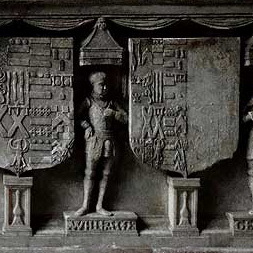An important man in the court of Edward IV, rising to the position of Lord Chamberlain. On the king’s death he supported his brother, the later Richard III, but something was not to Richard’s liking and during a Council meeting at the Tower of London, he accused Hastings and others of plotting against him. The others were imprisoned but Hastings was dragged outside and beheaded there and then, thus starting the charming tradition of beheadings on Tower Green.
This section lists the memorials where the subject on this page is commemorated:
William, Lord Hastings
Commemorated ati
Tower of London execution site
Catling wrote the poem as well as creating the sculpture. Doesn't that cushio...
Other Subjects
Thomas Bowyer
Burnt at the stake in Bow (or possibly Stratford) for his Protestant beliefs.
Stratford Martyrs
The church website has done a very thorough job on the history not just of the memorial but the church and the area so we quote them here on the background to the martyrs: "In 1553 Queen Mary Tudor...
Thomas Wentworth, Earl of Strafford
Born Chancery Lane. An unpopular Lord Lieutenant of Ireland. Supported Charles I against Parliament and so the Long Parliament impeached him and he was beheaded on Tower Hill.
Tyburn tree
The first recorded execution here was the hanging of the champion of London's poor, William Fitz Osbern in 1196. Back then there may have been a real tree but in 1571 the 'Tyburn Tree' was erected....
Previously viewed
Southwark Council
The London Borough of Southwark was created as an amalgamation of the Metropolitan Boroughs of Southwark, Camberwell and Bermondsey. Southwark council annually invites proposals for new plaques fro...
Diamond Jubilee of Queen Elizabeth II
Our picture shows Queen Elizabeth II in the River Thames Diamond Jubilee Pageant which took place in the cold and pouring rain on 3 June. Diamond represents 60 years.
Cara Leland Rogers Duff Broughton, Lady Fairhaven
Born in Fairhaven, Massachusetts, her father, Henry Huttleston Rogers, being immensely wealthy. 1890 married Bradford Ferris Duff but she was widowed aged 23. Married Urban Broughton 12 November 18...
Ealing Council
Governing body of the London Borough of Ealing, Formed in 1965 by the merging of the Municipal Boroughs of Acton, Ealing and Southall.
Councillor George Hickling
Mayor of St Pancras 1905 - 6. Kentish Towner refers to "a coal merchants George Hickling & Co, then to be found on the corner of Regis Rd." in the late 1800s. Seems likely to be the same man.











Comments are provided by Facebook, please ensure you are signed in here to see them